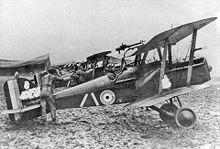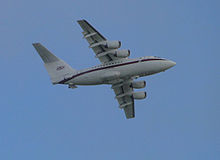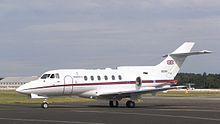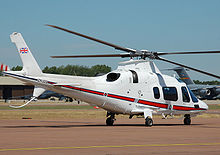- No. 32 Squadron RAF
-
No. 32 (The Royal) Squadron RAF 
Active 12 Jan 1916 - 29 Dec 1919
1 Apr 1923 - 3 Feb 1969
3 Feb 1969 - presentCountry  United Kingdom
United KingdomBranch  Royal Air Force
Royal Air ForceRole Air Transport Base RAF Northolt Nickname The Royal Motto Latin: Adeste Comites
("Rally round, comrades")post 1950 aircraft insignia 
Equipment BAe 146, BAe 125 & Agusta A109 Battle honours Western Front, 1916-1918
Somme, 1916-1918*
Arras
Ypres, 1917*
Amiens
France and Low Countries, 1939-1940*
Battle of Britain, 1940*
Home Defence, 1940-1942
Dieppe*
North Africa, 1942-1943*
Italy, 1943
South East Europe, 1944-1945*
Gulf 1991
The honours marked with an asterisk (*) are those emblazoned on the Squadron Standard[1]Insignia Squadron Badge heraldry A hunting horn stringed[2] Squadron Codes KT (Oct 1938 - Sep 1939)
GZ (Sep 1939 - Nov 1942, Jul 1944 - May 1949)No. 32 (The Royal) Squadron (sometimes written as No. XXXII(TR) Squadron) of the Royal Air Force at present operates from RAF Northolt, west London, in the VIP and general air transport roles.
Contents
History
Formation
No. 32 Squadron was formed as part of the Royal Flying Corps on 12 January 1916 at Netheravon and moved to France as a fighter squadron equipped with Airco DH.2s in May.[3] On 1 July 1916, its Commanding Officer, Major Lionel Rees was engaged in a combat with eight German Albatros two-seaters, and although wounded in the leg, managed to scatter the German aircraft, driving down two of the enemy, for which action he was awarded the Victoria Cross.[3]
The squadron continued to fly patrols over the Western Front, including over the Somme and Arras battlefields, for a year before beginning to re-equip with the Airco DH 5, specialising in ground attack missions. These in turn began to be replaced by the S.E.5a in December 1917 which were flown for the rest of the war on fighter and ground attack missions. On 1 April 1918 No. 32 became part of the new Royal Air Force. In March 1919, the squadron returned to the UK as a cadre and disbanded on 29 December 1919.[4] During the war just ended, sixteen aces had served in its ranks. They included: future Air Marshal Arthur Coningham DSO, MC, DFC; Walter Tyrrell, MC ; Arthur Claydon, DFC; John Donaldson, DSC, DFC, CdG; Wilfred Green, DFC, MM, CdG; Frank Hale, DFC; Hubert Jones, MC, AFC; William Curphey, MC; Maxmillian Mare-Montembault, MC; and George Lawson, DFC.
Between the Wars
The squadron reformed on 1 April 1923 at Kenley as a single flight of Sopwith Snipe fighters. A second flight was formed on 10 December 1923 and a third brought the squadron up to strength on 1 June 1924. Gloster Grebes were received at the end of 1924 and were replaced by Gloster Gamecocks two years later. Equipped in succession with Armstrong Whitworth Siskins, Bristol Bulldogs and Gloster Gauntlets, No. 32 Squadron received the Hawker Hurricane in October 1938.
Second World War
In May 1940, the squadron flew patrols over northern France and took part in the defence of south-east England based at RAF Biggin Hill during the opening weeks of the Battle of Britain before moving to northern England at the end of August 1940.[5] The Squadron's Hurricanes saw little action throughout 1941, but did attempt, unsuccessfully, to escort the Fairey Swordfish biplanes of 825 Naval Air Squadron during their doomed attempt to stop the German warships Scharnhorst, Gneisenau and Prinz Eugen during the Channel Dash on 12 February 1942,[6] and then carried out a number of night intruder operations before being deployed overseas.[7]
Following Operation Torch, the Anglo American invasion of North Africa, in December 1942, 32 Squadron deployed with its Hurricanes to Algeria, converting to the Supermarine Spitfire by July 1943.[6] Operations included a deployment to Greece, where the squadron took part in the Greek Civil War from September 1944 to February 1945.
Post-war
After the end of the Second World War, the squadron continued as a fighter squadron, flying Spitfires, Vampires and Venoms from bases in Palestine, Cyprus, Egypt, Persian Gulf, Malta and Jordan. In January 1957, the squadron converted to Canberra bombers at RAF Weston Zoyland, flying these from Cyprus, remaining there until disbanding on 3 February 1969.
VIP transport
See also: Air transport of the Royal Family and government of the United KingdomThe Metropolitan Communications Squadron was formed on 8 April 1944 by the renaming of No. 510 Squadron for VIP air transport. Simultaneous with No.32 Squadron being disbanded in Cyprus in February 1969, the Metropolitan Communications Squadron was renamed No. 32 Squadron. It operated a variety of aircraft, including Hawker Siddeley Andovers and Westland Whirlwind helicopters.
The squadron acquired four HS.125 CC.1s business jets in 1971. These would be supplemented and then replaced by two HS.125 CC.2s delivered in 1973 and 6 BAe 125 CC.3s delivered in 1982 and 1983. Five CC.3s remain in service. Aérospatiale Gazelle helicopters served with the squadron from 1976 onwards. These were replaced by initially two (later three) Twin Squirrels in 1996.
On 1 April 1995, the Queen's Flight, equipped with BAe 146 CC.2 and Wessex HCC.4 aircraft, was merged into No. 32 Squadron to become No. 32 (The Royal) Squadron. Since then, 32 Squadron's aircraft have served as transports in several recent conflicts including Operation Granby (Gulf War), Operation Veritas (Afghanistan) and Operation Telic (Iraq 2003). The merged squadron continues to be referred to in the press and by the public (inaccurately) as the Royal Flight or the Queen's Flight. This merger ended the RAF's provision of dedicated VIP transport aircraft: the aircraft of No. 32 Squadron are only available to VIP passengers if not needed for military operations. This was declared officially in 1999, with the MOD stating "the principal purpose of 32 Squadron [is] to provide communications and logistical support to military operations; the Squadron's capacity should be based on military needs only; and any royal or other non-military use of... spare capacity is secondary to its military purpose."[8]
In 2004 the squadron's aircraft lost their distinctive livery inherited from The Queen's Flight, featuring red flying surfaces. This was due to the concern over the aircraft's vulnerability to terrorist attack. While they do carry missile countermeasures it is felt that a more civilian-like livery lowered the profile of the squadron's aircraft.
In May 2005 the Defence Logistics Organisation's Helicopter and Islander Combined (HIC) Integrated Project Team (IPT) awarded AgustaWestland a five-year contract from 1 April 2006 to provide three AgustaWestland A109Es to replace the three Twin Squirrels. This contract was extended on 31 March 2011 to allow two of the A109Es to continue in use for a further year.[9] Two preserved examples of the squadron's ex-Queen's Flight Wessex helicopters can be seen at The Helicopter Museum in Weston-super-Mare and RAF Hendon air museum.
Squadron strength
- 'A' Flight - 2 BAe 146 CC.2
- 'B' Flight - 2 Agusta A109
- 'C' Flight - 6 BAe 125 CC.3
See also
- Air transports of Heads of State
- Air Mobility Command 89th Airlift Wing -
 United States
United States - 437 (Husky) Transport Squadron -
 Canada
Canada - No. 42 Squadron RNZAF -
 New Zealand
New Zealand - No. 34 Squadron RAAF -
 Australia
Australia
References
Notes
Bibliography
- Halley, James J. The Squadrons of the Royal Air Force & Commonwealth 1918-1988. Tonbridge, Kent, UK: Air Britain (Historians) Ltd., 1988. ISBN 0-85130-164-9.
- Hobson, Chris. A brief history of 32 Squadron Royal Air Force. 1986
- Jefford, Wing Commander C.G., MBE,BA,RAF (Retd). RAF Squadrons, a Comprehensive Record of the Movement and Equipment of all RAF Squadrons and their Antecedents since 1912. Shrewsbury, Shropshire, UK: Airlife Publishing, 2001. ISBN 1-84037-141-2.
- Lewis, Gwilym Hugh. Wings over the Somme. London: William Kimber, 1976. ISBN 0-7183-0324-5. (republished by Bridge Books of Wrexham, Wales in 1994. ISBN 1-872424-38-4.)
- Moyes, Philip J.R. Bomber Squadrons of the RAF and their Aircraft. London: Macdonald and Jane's, 1964 (2nd edition 1976). ISBN 0-354-01027-1.
- Rawlings J.D.R. "History of No. 32 Squadron". Air Pictorial, November 1971, Vol. 33 No. 11. pp. 424–427.
- Rawlings, John. Fighter Squadrons of the RAF and their Aircraft. London: Macdonald and Jane's Publishers Ltd., 1969 (second edition 1976). ISBN 0-354-01028-X.
- Unknown. A Short History of No. 32 Squadron Royal Air Force, 1916-1966. Nicosia, Cyprus: Paratiritis Publications, 1966.
External links
- 32 squadron RAF website
- No 32 Squadron RFC/RAF 1918
- Squadron histories for nos. 31-35 sqn on rafweb
- No 32 Squadron Aircraft & Markings 1916 - 1931
- No 32 Squadron Aircraft & Markings 1931 - 1969
- HIC IPT Web page
Related content
Currently active Inactive 1 · 4 · 10 · 13 · 20 · 21 · 23 · 25 · 26 · 34 · 35 · 36 · 37 · 38 · 40 · 42 · 43 · 44 · 46 · 48 · 49 · 50 · 52 · 53 · 55 · 58 · 59 · 61 · 62 · 63 · 64 · 65 · 66 · 67 · 68 · 69 · 70 · 71 · 73 · 74 · 75 · 76 · 77 · 79 · 80 · 81 · 82 · 83 · 85 · 86 · 87 · 88 · 89 · 90 · 91 · 92 · 93 · 94 · 95 · 96 · 97 · 98 · 102 · 103 · 104 · 105 · 106 · 107 · 108 · 109 · 110 · 111 · 112 · 113 · 114 · 115 · 116 · 117 · 118 · 119 · 120 · 121 · 122 · 123 · 124 · 125 · 126 · 127 · 128 · 129 · 130 · 131 · 132 · 133 · 134 · 135 · 136 · 137 · 138 · 139 · 140 · 141 · 142 · 143 · 144 · 145 · 146 · 147 · 148 · 149 · 150 · 151 · 152 · 153 · 154 · 155 · 156 · 157 · 158 · 159 · 160 · 161 · 162 · 163 · 164 · 165 · 166 · 167 · 168 · 169 · 170 · 171 · 172 · 173 · 174 · 175 · 176 · 177 · 178 · 179 · 180 · 181 · 182 · 183 · 184 · 185 · 186 · 187 · 188 · 189 · 190 · 191 · 192 · 193 · 194 · 195 · 196 · 197 · 198 · 199 · 200 · 201 · 204 · 205 · 209 · 210 · 211 · 212 · 213 · 214 · 215 · 217 · 218 · 219 · 220 · 221 · 222 · 223 · 224 · 225 · 226 · 227 · 228 · 229 · 231 · 232 · 233 · 234 · 235 · 236 · 237 · 238 · 239 · 240 · 241 · 242 · 243 · 244 · 245 · 246 · 247 · 248 · 249 · 250 · 251 · 252 · 253 · 254 · 255 · 256 · 257 · 258 · 259 · 260 · 261 · 262 · 263 · 264 · 265 · 266 · 267 · 268 · 269 · 270 · 271 · 272 · 273 · 274 · 275 · 276 · 277 · 278 · 279 · 280 · 281 · 282 · 283 · 284 · 285 · 286 · 287 · 288 · 289 · 290 · 291 · 292 · 293 · 294 · 295 · 296 · 297 · 298 · 299 · 353 · 354 · 355 · 356 · 357 · 358 · 360 · 361 · 510 · 511 · 512 · 513 · 514 · 515 · 516 · 517 · 518 · 519 · 520 · 521 · 524 · 525 · 526 · 527 · 528 · 529 · 530 · 531 · 532 · 533 · 534 · 535 · 536 · 537 · 538 · 539 · 540 · 541 · 542 · 543 · 544 · 547 · 548 · 549 · 550 · 567 · 569 · 570 · 571 · 575 · 576 · 577 · 578 · 582 · 586 · 587 · 595 · 597 · 598 · 618 · 619 · 620 · 621 · 622 · 623 · 624 · 625 · 626 · 627 · 628 · 629 · 630 · 631 · 635 · 639 · 640 · 644 · 650 · 651 · 652 · 653 · 654 · 655 · 656 · 657 · 658 · 659 · 660 · 661 · 662 · 663 · 664 · 665 · 666 · 667 · 668 · 669 · 670 · 671 · 672 · 673 · 679 · 680 · 681 · 682 · 683 · 684 · 691 · 692 · 695
Australian Flying Corps (AFC) units attached
to the RAF during the First World WarCommonwealth air force units attached to
the RAF during the Second World War.Squadrons formed from non-Commonwealth
personnel during the Second World WarArgentineBelgian349 · 350CzechoslovakDutchFrenchGreek335 · 336NorwegianYugoslavRoyal Auxiliary Air Force Special ReserveAuxiliary Air ForceFleet Air Arm of the RAF (1924–1939) Formations and units Commands · Groups · Stations · Wings · Aircraft squadrons · Aircraft flights · Conversion units · Regiment squadrons

Branches and components RAF Regiment · RAF Chaplains Branch · RAF Intelligence · RAF Legal Branch · Princess Mary's RAF Nursing Service · RAF Police · Search and Rescue Force · Mountain Rescue Service
Reserve forces Associated civil organizations Air Training Corps · RAF Association · RAF Centre of Aviation Medicine
Equipment List of RAF aircraft · List of RAF missiles
Personnel Symbols and uniform Categories:- Royal Air Force aircraft squadrons
- Military units and formations established in 1916
- Royal Flying Corps squadrons
- Air transport of heads of state
- 1916 establishments in the United Kingdom
Wikimedia Foundation. 2010.




